More than 100 years ago today, Germany signed its armistice with the Allied Powers, effectively ending World War I. The devastation resulting from “the war to end all wars” forever transformed the global political, economic, and cultural landscape. This Veterans Day, join HeinOnline in discovering the causes, major events, and effects of World War I using the primary sources themselves.
Before We Get Started
Don’t miss out! Make sure you have the databases mentioned in this post. Follow the links below to start a trial today.
World Treaty Library
This monumental collection brings together Rohn, Dumont, Bevans, Martens, League of Nations, United States, and United Nations treaties into one easy-to-use and fully searchable database. Also included are hundreds of related treaty publications, scholarly articles chosen by our editors, and a bibliography of related publications. Learn more.
History of International Law
Includes hundreds of titles and more than a million pages dating back to 1690 on International Law subjects such as War & Peace, the Nuremberg Trials, Law of the Sea, International Arbitration, Hague Conferences and Conventions and much more! Learn more.
Law Journal Library
Contains more than 2,700 law and law-related periodicals. Subjects covered include criminal justice, political science, technology, human rights, and more. Coverage for all journals is from inception and goes through the most currently published issues allowed based on contracts with publishers. Learn more.
Prelude to the War
Though some dispute the war’s exact causes, many scholars agree that the conflict stemmed from a deep-seated and staggeringly complex interplay of political, economic, militaristic, and diplomatic factors.
A “Powder Keg” in the Balkans
By the mid-nineteenth century, the European continent (and much of the rest of the world) was controlled by just a few powers: the British Empire, the French Empire, the Russian Empire, and the Ottoman Empire. By the late 1870s, a newly unified German Reich and an Austro-Hungarian Empire had joined the fold. Meanwhile, the Ottoman Empire (encompassing much of the Balkan peninsula, North Africa, and Western Asia) was in major decline.
After sections of the Balkan peninsula began to desire independence, European leaders met at the Congress of Berlin (1878) to discuss political reorganization. In what was considered to be an achievement toward peace, the resulting Treaty of Berlin established new independent nations (i.e. Bulgaria) and annexed some existing territories to other empires (i.e. Bosnia and Herzegovina by Austria-Hungary). Tensions remained however, creating a “powder keg” that would explode into a world war more than thirty years later.
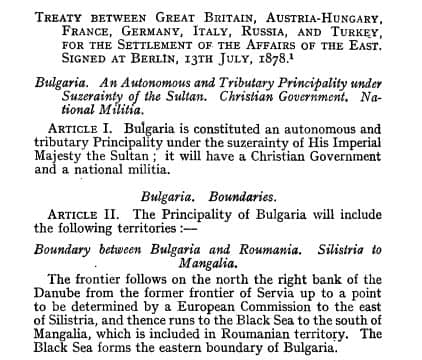
A European Arms Race
The unification of the German Reich, meanwhile, vastly increased the state’s industrial and economic power. Its new leader, Kaiser Wilhelm II, had no intention of being reduced to a figurehead leader as in other empires. Admiring the reach and influence of Great Britain, Wilhelm concentrated his efforts on emulating the empire, resulting in an Anglo-German arms race lasting more than fifteen years.
Germany was not alone. Simultaneously, the British, French, Austro-Hungarian, Italian, and Russian empires each sought to surpass the military preparedness of the others, setting the stage for inevitable world destruction.
A Tangled Web of Alliances
With empires in decline, unstable new nations, and increased armaments across the continent, the European powers attempted to maintain a balance of power—a tactic of ensuring that no one nation becomes powerful enough to dominate the others. The result was a complex web of political and military alliances, both publicly acknowledged and secret. By the 1880s, Austria-Hungary, Germany, and Italy had entered into an alliance with the primary purpose of isolating France. By 1904, France had entered into an alliance with Russia and an Entente Cordiale with Britain. Further, in 1907, Britain entered into the Anglo-Russian Convention.
The interplay between these agreements polarized Europe into two coalitions: the Triple Alliance (Austria-Hungary, Germany, and Italy) and the Triple Entente (Britain, France, and Russia).
The Keg Explodes
The Assassination of Archduke Franz Ferdinand
The conditions were perfect for one European crisis to launch the continent into a full-scale war. That crisis arose when on June 28, 1914, the Austro-Hungarian heir, Archduke Franz Ferdinand, was killed by Yugoslavist, Bosnian, and Serbian assassins funded by the Kingdom of Serbia.
In response, Austria-Hungary presented a series of demands to Serbia. The latter accepted all demands but one—that Austrian officials enter Serbia to investigate the assassination. Austria subsequently ended its diplomatic relationships with the Kingdom of Serbia and on July 28, declared war.
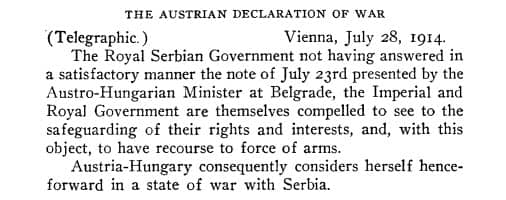
Russia declared its support for Serbia, launching a domino effect of invoked alliances. In support of Austria-Hungary, Germany declared war on Russia, and then France. In just a few days, Belgium, Great Britain, and France, had joined Russia’s side. The opposing countries ultimately formed two coalitions: The Allies (consisting of major powers France, Britain, and Russia) and the Central Powers (consisting of major powers Germany, Austria-Hungary, the Ottoman Empire, and Bulgaria). The Balkan conflict thus escalated into a war of many names—the Great War, the Seminal Catastrophe, “the war to end all wars,” or, as most know it, World War I.
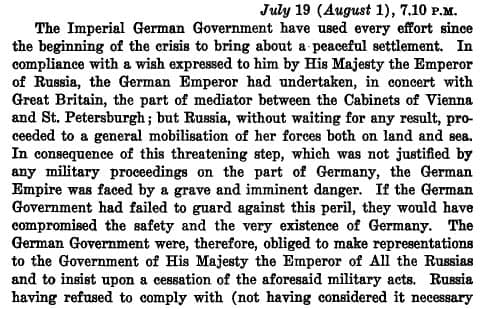

America Joins the Fight
After just six months of war, more than one million soldiers had perished in battle. The war soon became one of attrition, with each side hoping to win by outlasting the other. Neither the Allies or the Central Powers could see victory, and their respective resources were draining fast. By 1917, the outbreak of revolution in Russia had began to tip the scale in the Central Powers’ favor—until the entry of the United States into the fray.
For the first few years of the war, the U.S. had remained neutral, engaging in trade and commerce with European countries regardless of their side in the war. This non-intervention policy was tested when a German U-boat sank the RMS Lusitania, a British liner holding nearly 130 American passengers. American President Woodrow Wilson demanded that Germany cease its attacks on passenger ships, warning that unrestricted naval warfare would violate international law. Germany initially complied, but ultimately resumed its unchecked naval warfare in 1916. After the sinking of the S.S. Sussex in 1916, the U.S. delivered an ultimatum to Germany, threatening war.
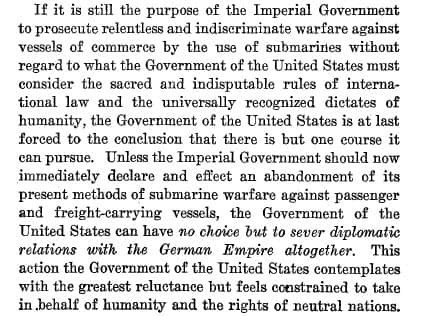
After further discovering an attempt by Germany to turn Mexico against the United States, President Wilson and the U.S. Congress declared war in April of 1917.
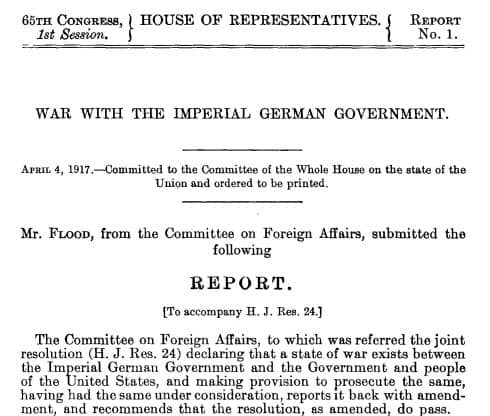
The Central Powers Collapse
The addition of American men, equipment, and resources to the Allied front was a necessary boost that greatly altered the trajectory of the war. Unable to withstand the stress of war any longer, Bulgaria signed the first armistice on September 29, 1918. The Ottoman Empire followed on October 30. Austria-Hungary signed its own armistice on November 3.
German defeat was all but certain, and murmurs of revolution spread throughout the Reich. Having lost the confidence of his failing empire, Kaiser Wilhelm abdicated his seat and fled the country. On November 11, 1918, Germany signed its armistice with the Allied powers, officially ending the war.
At the eleventh hour of the eleventh day of the eleventh month, a ceasefire was called. The Great War was over.
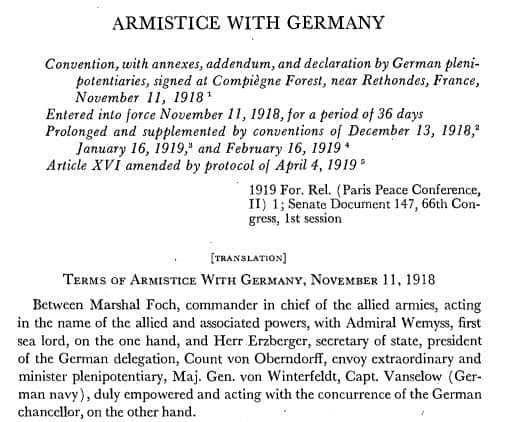
Did You Enjoy This Post?
Interested in reading about other wars and their impact? Check out related posts below.
- Secrets of the Serial Set: The Pacific Theater of World War II
- The Nuremberg Trials and Their Profound Impact on International Law
- It’s Getting Hot in Here: The Cuban Missile Crisis and the Cold War
Don’t miss out! Hit Subscribe to have blogs like these sent directly to your inbox.



